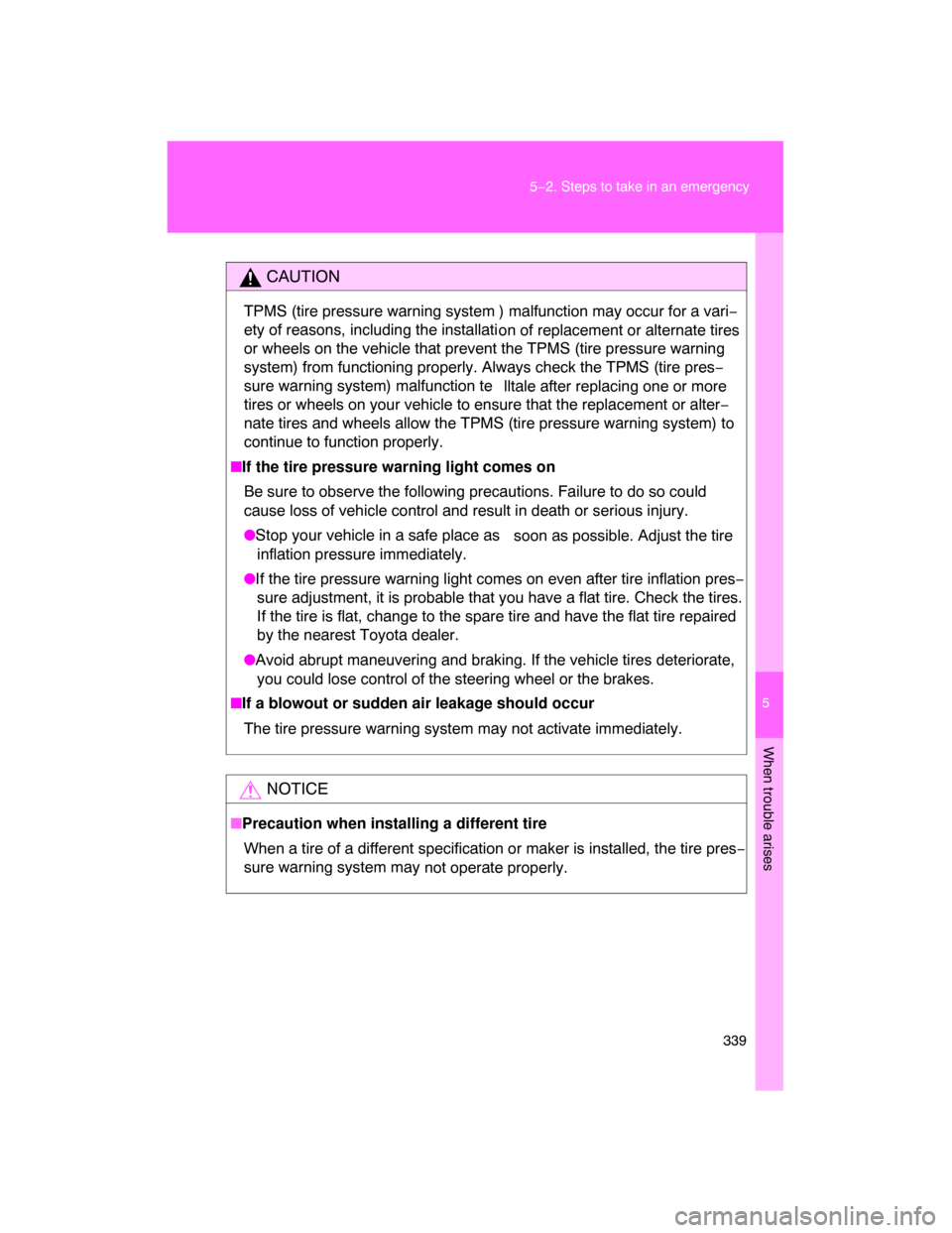Page 79 of 400

80 1−7. Safety information
CAUTION
� SRS airbag precautions
Observe the following precautions regarding the airbags.
Failure to do so may cause death or serious injury.
� The driver and all passengers in the vehicle must wear their seat belts
properly.
The SRS airbags are supplemental devices to be used with the seat belts.
� The SRS driver airbag deploys with considerable force, and can cause
death or serious injury especially if the driver is very close to the airbag.
The National Highway Traffic Safety
Administration (“NHTSA”) advises:
Since the risk zone for driver airbag is the first 2 − 3 in. (50 − 75 mm) of infla−
tion, placing yourself 10 in. (250 mm) fr
om your driver airbag provides you
with a clear margin of safety. This distance is measured from the center of
the steering wheel to your breastbone.
If you sit less than 10 in. (250 mm)
away now, you can change your driving position in several ways:
�Move your seat to the rear as far as you can while still reaching the
pedals comfortably.
�Slightly recline the back of the seat.
Although vehicle designs vary, many drivers can achieve the 10 in.
(250 mm) distance, even with the driver seat all the way forward, sim−
ply by reclining the back of the seat somewhat. If reclining the back of
your seat makes it hard to see the road, raise yourself by using a firm,
non−slippery cushion, or raise the seat if your vehicle has that feature.
�If your steering wheel is adjustable, tilt it downward. This points the air−
bag toward your chest instead of your head and neck.
The seat should be adjusted as recommended by NHTSA above, while still
maintaining control of the foot pedals, steering wheel, and your view of the
instrument panel controls.
Page 111 of 400

113
2−1. Driving procedures
2
When driving
NOTICE
� If you get a flat tire while driving
A flat or damaged tire may cause the following situations. Hold the steering
wheel firmly and gradually press the brake pedal to slow down the vehicle.
� It may be difficult to control your vehicle.
�The vehicle will make abnormal sounds.
�The vehicle will behave abnormally.
Replace a flat tire with a new one. (
P. 342)
� When encountering flooded roads
Do not drive on a road that has flooded after heavy rain etc. Doing so may
cause the following serious damage to the vehicle.
� Engine stalling
�Short in electrical components
�Engine damage caused by water immersion
In the event that you drive on a flooded road and the vehicle is flooded, be
sure to have your Toyota dealer check the following.
�Brake function
�Changes in quantity and quality of oil and fluid used for the engine, trans−
mission, transfer (4WD vehicles), differentials, etc.
� Lubricant condition for the propeller shaft, bearings and suspension joints
(where possible) and the function of all joints, bearings, etc.
Page 221 of 400
224
3−2. Using the audio system
Using the steering wheel audio switches (if equipped)
Turning on the power
Press when the audio system is turned OFF.
The audio system can be turned off by holding the switch down until the
system turns off.
Changing the audio source
Press when the audio system is turned ON. The audio source
changes as follows each time is pressed.
CD player without changer:
FM1 FM2 CD AUX AM
CD player with changer:
FM1 FM2 CD changer AUX AM SAT1 SAT2SAT3
Adjusting the volume
Press “+” on to increase the volume and “–” to decrease the
volume.
Press and hold “+” or “–” on to continue increasing or decreasing
the volume. Some audio features can be contro lled using the switches on the
steering wheel.
Vo l u m e
Radio: Select radio stations
CD: Select tracks, files
(MP3 and WMA) and discs
Power on, select audio
source
Page 222 of 400
225
3−2. Using the audio system
3
Interior features
Selecting a radio station
Press to select the radio mode.
Press “
” or “ ” on to select a preset station.
To scan for receivable stations, press and hold the switch until you
hear a beep.
Selecting a track/file
Press to select the CD mode.
Press “
” or “
” on to select the desired track/file.
Selecting a disc in the CD player (CD player with changer only)
Press to select the CD mode.
Press and hold “
” or “
” on until you want to listen to is
set.
CAUTION
� To reduce the risk of an accident
Exercise care when operating the audio switches on the steering wheel.
Page 334 of 400

5
When trouble arises
339 5−2. Steps to take in an emergency
CAUTION
TPMS (tire pressure warning system ) malfunction may occur for a vari−
ety of reasons, including the installati
on of replacement or alternate tires
or wheels on the vehicle that prevent the TPMS (tire pressure warning
system) from functioning properly. Always check the TPMS (tire pres−
sure warning system) malfunction te
lltale after replacing one or more
tires or wheels on your vehicle to ensure that the replacement or alter−
nate tires and wheels allow the TPMS (tire pressure warning system) to
continue to function properly.
�If the tire pressure warning light comes on
Be sure to observe the following precautions. Failure to do so could
cause loss of vehicle control and result in death or serious injury.
�Stop your vehicle in a safe place as
soon as possible. Adjust the tire
inflation pressure immediately.
�If the tire pressure warning light comes on even after tire inflation pres−
sure adjustment, it is probable that you have a flat tire. Check the tires.
If the tire is flat, change to the spare tire and have the flat tire repaired
by the nearest Toyota dealer.
�Avoid abrupt maneuvering and braking. If the vehicle tires deteriorate,
you could lose control of the steering wheel or the brakes.
�If a blowout or sudden air leakage should occur
The tire pressure warning system may not activate immediately.
NOTICE
�Precaution when installing a different tire
When a tire of a different specification or maker is installed, the tire pres−
sure warning system may
not operate properly.